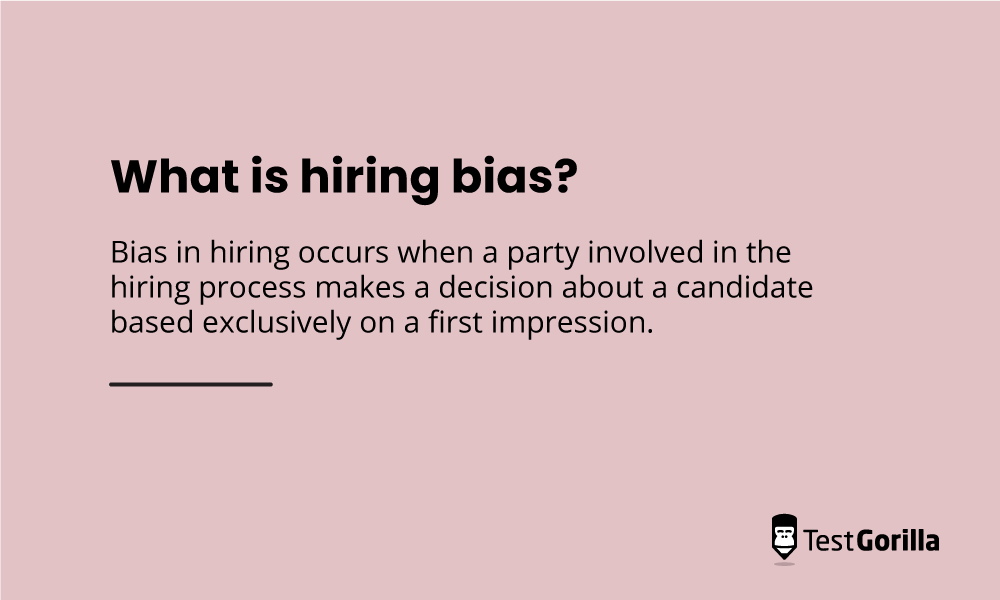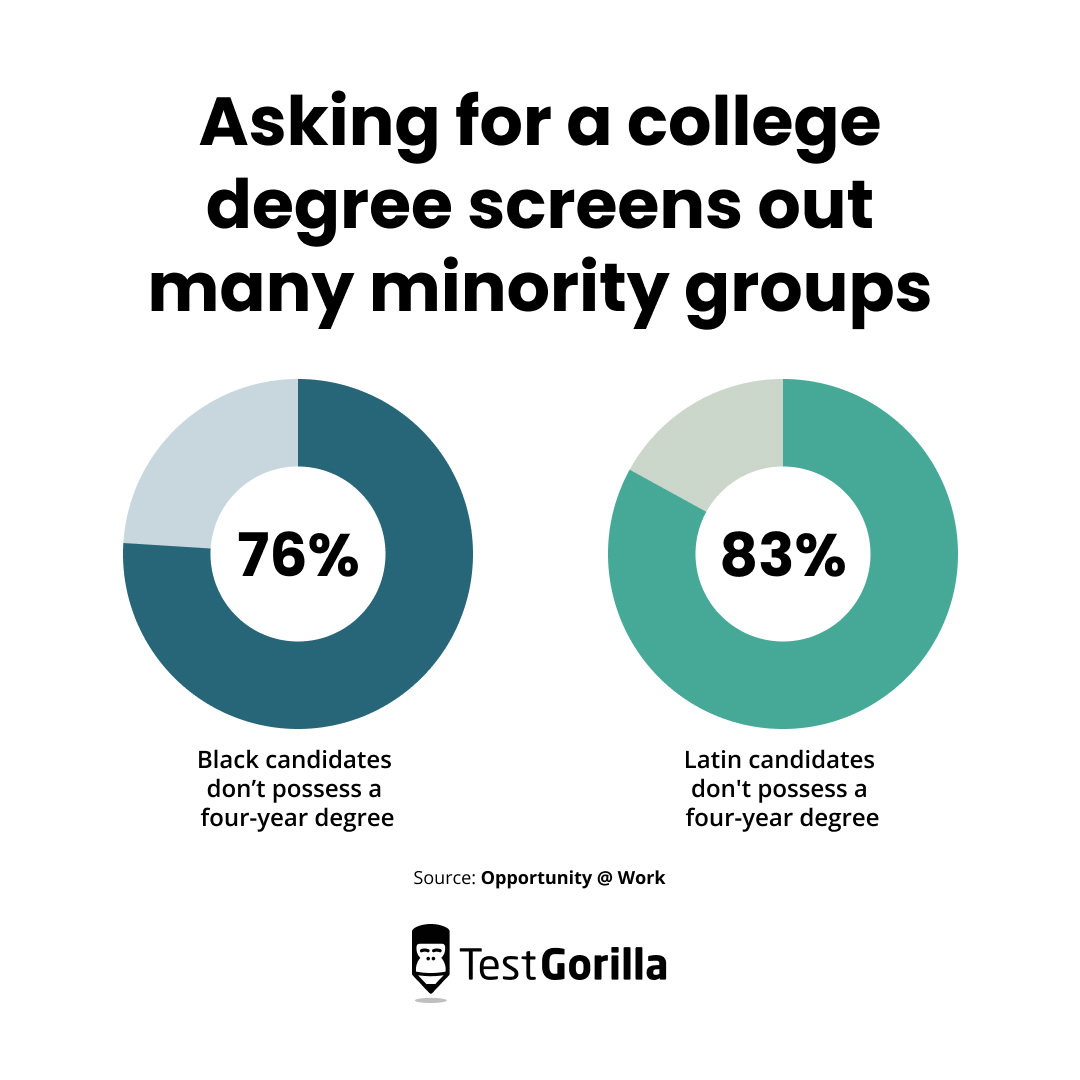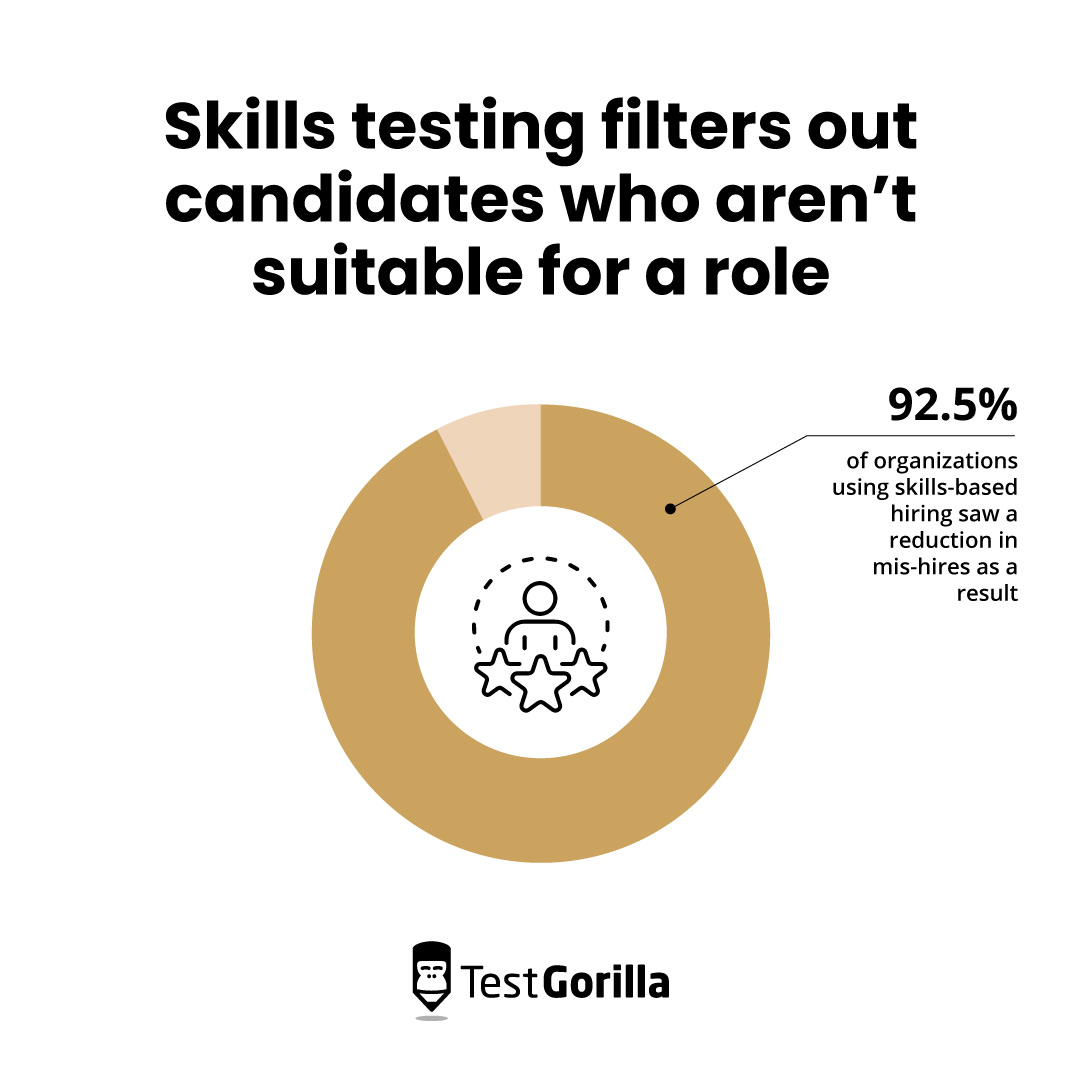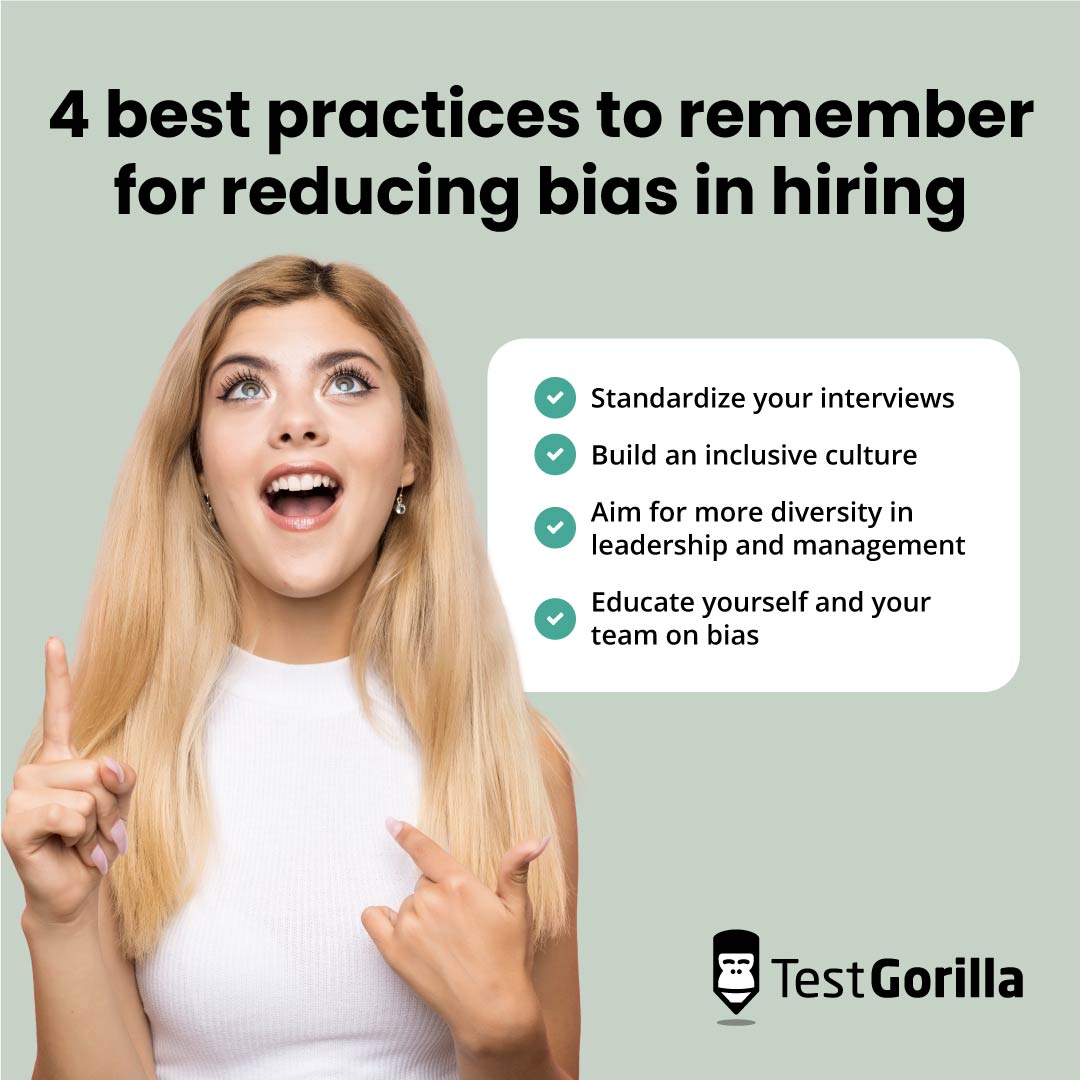Even when you’re careful to hire consciously, it’s hard to avoid the fact that biases are innate. They aren’t always easy to identify in the heat of the moment, especially when you’re under pressure to fill an open role quickly.
But the consequences of hiring bias are real. Bias in hiring decisions could lead to expensive mis-hires based on a misplaced “gut feeling.” Or, in a worst-case scenario, it could even result in workplace discrimination – harming your workers and your ability to attract new talent.
Fortunately, talent assessments are a reliable way to mitigate the effects of bias in hiring.
In this guide, we explore how this data-driven, objective approach reduces hiring bias and helps you add to your company culture.
With our best practices and top tips, your company stands to benefit from a more equitable hiring strategy.
Table of contents
What is hiring bias?
Bias in hiring occurs when a party involved in the hiring process makes a decision about a candidate based exclusively on a first impression. Hiring bias may be based on anything from a candidate’s name, race, or gender to whether a hiring manager feels they’d be fun to socialize with outside of work.
Hiring biases are usually unconscious or implicit – people don’t realize they’re making these judgements. But it’s possible for people to be consciously biased and to make active hiring decisions based on irrelevant criteria.
And even implicit bias in hiring is a form of discrimination that can seriously damage your company’s diversity.
Why reducing hiring bias is important
We know that diversity makes a meaningful difference to a company’s performance. Diverse businesses perform 1.32 times better on average than their less diverse competitors.
But diversity hiring and hiring bias are completely incompatible. Research shows:
When job applicants from racial minority groups reveal their race on their resume, they see a 50% drop in invitations to interview
Applicants with criminal records are 50% less likely than other candidates to receive a callback or a job offer
89% of hiring managers admit to making snap judgements about candidates within the first 15 minutes of an initial interview[1]
The bottom line is that companies hiring quality candidates based on their skill set and abilities build a more diverse workforce (and a better company culture as a result).
But as these statistics show, bias in the hiring process means companies risk expensive mis-hires and a more homogeneous, less accepting culture. In turn, that limits their ability to attract strong candidates and remain competitive in the search for top talent.
Different types of bias in hiring
Bias in hiring takes many different forms. Here’s an at-a-glance guide to some of the most common forms of hiring bias and what they mean.
Type of bias | What it is |
1. Affinity bias in hiring (or similarity bias in hiring) | Bias toward candidates who have qualities in common with the hiring manager |
2. Age bias in hiring | Bias toward or against candidates based on their age |
3. AI bias in hiring | The bias that occurs in AI hiring algorithms when the data sets used to run the AI reflect existing societal biases |
4. Anchoring bias in hiring | The bias that occurs when a hiring manager makes a decision based on the first piece of information they receive about a candidate |
5. Beauty bias in hiring | Bias toward candidates seen as attractive, or against candidates seen as unattractive |
6. Confirmation bias in hiring | Seeking and relying on information about a candidate’s skills or abilities that reflects what you already believe to be true |
7. Conformity bias in hiring | The bias that occurs when a hiring manager prefers a candidate and other hiring committee members are afraid to disagree |
8. Criminal record bias in hiring | Bias against candidates with a criminal record or history (some companies address this bias with fair chance hiring policies) |
9. Disability bias in hiring | Bias toward or against candidates based on their disability status |
10. Gender bias in hiring | Bias toward or against candidates based on gender (or gender presentation or transgender status) |
11. Halo effect and horn effect | The bias that occurs when a hiring manager sees a trait they like or dislike in a candidate and assumes they must have other desirable or undesirable qualities |
12. Illusory correlation bias in hiring | The bias that occurs when an interviewer sees a trait in a candidate, assumes it correlates to a skill or ability, and uses it to make hiring decisions |
13. Name bias in hiring | Bias against candidates based on their name (often overlaps with racial bias) |
14. Racial bias in hiring | Bias toward or against candidates based on their race or ethnicity |
15. Religion bias in hiring | Bias toward or against candidates based on their religion |
16. Sexual orientation bias in hiring | Bias toward or against candidates based on their sexual orientation |
The difficulties with bias in hiring
One of the major challenges companies face when trying to stop hiring bias is that it’s often inherent and unconscious. Most people have implicit biases, and it’s often uncomfortable to examine them closely.
Plus, it isn’t always enough to be mindful of unconscious bias in hiring. When you assume that being aware of bias is enough and don’t take steps to prevent it, you make room for unconscious biases to run riot in your hiring processes.
It’s also true that many unconscious biases are positive, and a lot of discussion about biases in hiring frames them as solely negative, taking forms such as racism or sexism.
It’s harder to identify positive biases as biases – and to treat them accordingly.
For example, if you used to work in nursing before entering your current field and you encounter a candidate with a similar background, the affinity bias you feel toward that candidate is still bias. But from the inside, it’s more likely to feel like kinship or respect.
Positive unconscious bias can also creep in when rehiring former employees over other qualified candidates.
But the biggest issue by far with biases in hiring is that traditional hiring methods perpetuate them.
Here’s how:
College degree requirements perpetuate bias against a group of people whose access to higher education is limited, including 76% of Black workers and 83% of Hispanic workers
Resumes perpetuate bias against those with gaps in their work history, such as parents who have taken parental leave or formerly incarcerated people
Unstructured interviews perpetuate bias against neurodivergent people, who often struggle with implicit social cues
Until you change your approach to hiring, you won’t be able to remove bias in the recruitment and selection process.
How talent assessments help with biases in hiring
When eliminating biases in hiring, there’s a clear solution: talent assessments. This approach to hiring comes with real, tangible benefits that reduce hiring bias and lead to better hiring.
Let’s see what talent assessments can do to help your business manage hiring bias.
Assesses actual skills
When surveyed by Deloitte, 80% of business executives agreed that hiring based on skills would reduce bias and improve fairness.
Assessing candidates to gauge their skills fosters a data-driven approach to hiring that reduces the potential for bias to enter the process. By using objective talent assessments, you judge all candidates according to the same framework.
Bias doesn’t enter into it, making your hiring and recruitment process more reliable.
Evaluates soft skills and personality
Our State of Skills-Based Hiring report found 73.5% of employers believe it’s more important for candidates to have great soft skills today than it was five years ago.
Soft skills, which include collaboration and communication, are the skills that help employees work with others effectively. It’s often hard to assess these skills without using objective tests.
Assessing soft skills is an opportunity for companies to identify unexpected culture adds in a data-driven and unbiased way.
Conversely, it helps businesses root out toxic employees before they’re hired.
Reduces mis-hires
The State of Skills-Based Hiring report shows that 92.5% of organizations using skills-based hiring saw a reduction in mis-hires as a result.
That’s because skills testing filters out candidates who aren’t suitable for a role, enabling hiring managers to focus their time on the people who have what it takes.
This is a great opportunity for hiring managers to learn more about each viable candidate, making it harder to hire based on biases.
Increases diversity
By focusing on skills over other traits, talent assessments make it easier to hire a more diverse workforce. Our State of Skills-Based Hiring report found that 91.1% of businesses using skills-based hiring methods saw an increase in diversity.
When candidates are judged solely on their abilities and skills, diverse candidates have a fairer chance of success.
It’s especially helpful for candidates without college degrees, a group that (as we’ve seen) is highly racially diverse.
But how does that benefit your business? Research from McKinsey shows candidates without degrees stay in their jobs 34% longer than other candidates, so diverse hiring can boost retention.
7 ways to use talent assessments to reduce bias in hiring
Talent assessments are a powerful tool when it comes to reducing bias in hiring.
Enact these best practices to use them as effectively as possible and keep your hiring process fair.
Reducing bias in hiring with talent assessments at a glance
Best practice | How it helps |
1. Gauge skills instead of resumes, education, or background | Removes the risks of bias that come with hiring based on resumes |
2. Consider culture add, not culture fit | Promotes a healthy company culture without fostering hiring biases |
3. Use talent assessments to determine the skills needed for each role | Helps businesses promote roles in a skills-focused, bias-free way from the first steps of the hiring process |
4. Evaluate each candidate’s personality | Limits the risk of making a mis-hire thanks to a candidate’s charming or forceful personality |
5. Hold every candidate to the same standard of performance | Keeps the hiring process as data-driven and fair as possible |
6. Offer reasonable accommodations | Gives candidates with disabilities an equitable playing field during hiring |
7. Upskill candidates who meet most qualifications | Fosters a culture of employee learning and development and doesn’t disadvantage candidates from non-traditional backgrounds |
1. Gauge skills instead of resumes, education, or background
Consider the information you learn about a candidate when you skim-read a resume:
Name
Age
Address
Educational background
Work history
Believe it or not, all of these can be vectors of hiring biases.
A candidate’s name could give away their racial background, potentially exposing them to racial bias. Their age could prompt a reaction influenced by ageist bias.
An address may carry socioeconomic connotations that influence a hiring manager’s gut reaction, especially when hiring remote employees who can live virtually anywhere.
And it stands to reason that a nontraditional educational background or work history could raise eyebrows for the wrong reasons.
The issue is that none of this information matters. As long as the candidate has the skills necessary to do the job and meet your hiring needs, they deserve fair consideration.
Talent assessments work because they take the focus off that unnecessary data, removing the possibility that it could lead to a biased hiring process.
Instead, skills assessments place hiring managers’ attention firmly on a candidate’s skills, making it easy to compare candidates directly on that basis.
When you objectively assess candidates with pre-employment tests, you also identify HiPos – high-potential employees who have the right skills, motivation, and leadership potential to succeed in senior roles.
2. Consider culture add, not culture fit
Many businesses used to hire based on “culture fit” – whether or not a candidate shared the values of the company. But over time, it became clear that the whole idea of culture fit relied on hiring managers’ personal biases and gut feelings.
It fostered a range of biases, including affinity bias and confirmation bias, and kept companies homogeneous and limited in terms of diversity.
Culture add, on the other hand, focuses on whether or not candidates can elevate the culture of a company. Hiring for culture add means looking for similarities in values while also celebrating differences in experience and perspective.
It comes with several key advantages, including:
Helping your company culture evolve, not stagnate
Promoting innovation through the exchange of ideas
Opening up new talent pools and fostering diversity
TakeFortyTwo, a digital agency, used questionnaires to assess cultural fit, but they revealed candidates’ personal interests instead of their values.
The company switched to using our tests, including our Culture Add test, leading to a more reliable and efficient hiring process that included assessing candidates’ skills, values, and behaviors.
3. Use talent assessments to determine the skills needed for each role
Skills-based hiring is a proven method – as long as you know the skills you need to screen for when hiring. If you don’t have that information, you could still end up hiring the wrong candidate for the job.
Prepare for a skills-based approach by using talent assessments to evaluate the skills your open role requires. Here’s how to do it:
Assess the function of the role, and determine which skills a new hire would need to succeed
Ask current staff in similar roles (or on the same team) to complete talent assessments to gauge their skills
Compare the two and prioritize the skills needed for the role
This puts you in a great position to write an inclusive, skills-based job description that focuses on the role’s core competencies.
To improve the candidate experience even further, avoid language that could reflect biases in hiring, like age requirements or degree requirements.
4. Evaluate each candidate’s personality
Talent assessments aren’t only useful for assessing role-specific hard skills. They’re also useful when it comes to evaluating candidates’ personalities.
A personality test, like the Enneagram test, could reveal important data about a candidate’s capacity for empathy, collaboration, and motivation – important qualities that affect the rest of your team’s experience with your new hire.
This matters because if you don’t pay attention to it, you may be at risk of hiring an asshole genius.
These candidates’ skills look great on paper, and they tend to perform well on talent assessments and in the interview process. They may be charming enough during the hiring process that it’s easy to succumb to hiring bias in their favor.
However, their personalities create major challenges for your other employees, to the point of creating a toxic workplace culture. And research shows a toxic culture is 10.4 times more powerful than compensation in predicting a company’s turnover rate.
By taking steps to avoid being charmed by these candidates, you reduce employee turnover and disengagement in the long term – saving you time and money.
5. Hold every candidate to the same standard of performance
A key advantage of talent assessments is that they’re driven by data. It’s easy to compare candidates’ performance directly without any other factors coming into play.
But it’s still your responsibility to use that data ethically. Make sure every candidate is held to the same standard and nobody gets special treatment, whether favorably or unfavorably.
Setting the right benchmark scores for your talent assessment tests is important. If you set it too high, you risk limiting your talent pool unnecessarily. But if you set it too low, you increase your risk of mis-hires.
Consider the following approaches to setting a benchmark score:
Use applicant data from previous hiring initiatives
Assess your current employees and use their scores as a benchmark
Compare test takers to each other and establish an average
Check out our guide to setting benchmark scores to learn more.
6. Offer reasonable accommodations
Candidates with disabilities face huge disadvantages when looking for work. In 2022, about 21% of disabled people in the US were employed – and that’s the highest the figure has been since recording began in 2008.
Needless to say, disability bias is a huge problem in hiring – but you can take steps to counter it.
When hiring people with disabilities, consider that they may need reasonable accommodations to access the same opportunities as other candidates. This doesn’t mean giving them an unfair advantage; it means leveling the playing field.
Examples of reasonable accommodations to offer during skills testing include:
Extra time on tests
Extra breaks
Different test formats, including the option to answer verbally
TestGorilla makes it easy to set up reasonable accommodations for talent assessments. Just select the accommodations each candidate will need when setting up your tests.
7. Upskill candidates who meet most qualifications
It’s tempting to think of role requirements as a fixed, hard-and-fast list candidates have to meet in full – regardless of their history, socioeconomic circumstances, or other mitigating factors.
But if a strong candidate doesn’t meet all the qualifications needed for the role, it doesn’t have to be the end of their hiring journey.
As long as they meet most of the requirements, it’s possible to use skills tests to upskill them where needed. Then you can hire them without creating a meaningful skills gap.
Here’s how to do it:
Use the results of the skills tests they took during hiring to establish where they need to improve
Work with them to develop an employee training and development plan
Continue monitoring their progress with regular skills testing over time
Candidates value opportunities to learn and grow at work. This approach could set your business apart as an employer that appreciates its people and helps them develop their skills.
Beyond talent assessments: 4 best practices to remember for reducing bias in hiring
Talent assessments are only the beginning. Eliminating biases in hiring requires working on other aspects of the hiring process and your broader company culture.
Follow these four tips to get started.
1. Standardize your interviews
We’ve already mentioned that unstructured interviews foster bias against neurodiverse candidates.
But they also leave interviewers relying heavily on charisma, even though the most charming candidates aren’t always the most skilled.
Structured, standardized job interview questions offer a more data-driven approach to interviewing. With structured interviews, it’s easier to compare candidates’ answers directly, point by point.
This makes it harder for affinity bias, confirmation bias, and illusory confirmation bias to take root during hiring.
2. Build an inclusive culture
Diverse, inclusive company cultures naturally contain less bias. They enable people from all walks of life to come together around a common goal and a shared set of values.
It’s one of the biggest benefits of hiring for culture add: Everyone contributes, and everyone has something to learn from everyone else.
Take steps to build a more inclusive culture, and the benefits will reach every part of your company – from your hiring process to your employer brand.
3. Aim for more diversity in leadership and management
In any company, change needs to be driven from the top down.
You should aim to build a more diverse leadership and management team to reflect the lack of hiring bias you want your business to show.
Build leadership development plans for diverse employees who show leadership potential. These plans develop their skills to prepare them for senior or management roles.
This approach promotes internal mobility for diverse workers, improving your ability to attract talent.
4. Educate yourself and your team on bias
The first step to overcoming hiring biases is admitting that you have biases of your own. From there, it’s easier to educate yourself and your team on bias, and work toward overcoming your biases.
Implicit bias training isn’t a one-time fix. You can’t attend one training session and expect it to cure you of biases (though we agree that would be nice).
Instead, use the knowledge you and your team gain through training as a basis for long-term behavioral change. Don’t get complacent about your biases; try your best to stay mindful.
For more best practices, read our guide on how to minimize unconscious bias during hiring.
Use talent assessments to mitigate bias in hiring
Bias in hiring is hard to control. Because it’s inherent (and often unconscious), hiring managers may not even realize they’re perpetuating it – leading to mis-hires, unfair hiring practices, and smaller talent pools.
But objective, data-driven hiring methods like talent assessments make it harder for hiring bias to take root.
By focusing on the information that matters and leaving out what doesn’t, skills-based hiring mitigates the risk of hiring bias.
The result? A more diverse, innovative company in a much better position to attract and retain top talent. It’s not hard to be biased in favor of that.
Are you curious about how else talent assessments can help your hiring practices? Learn how to use them when hiring Gen Z, a demographic known to value diversity.
And when you’re ready to hire for your next role, don’t forget to check out the range of tests available in our test library.
Source
“The Most Surprising Hiring Bias Statistics And Trends in 2023”. (September 5, 2023). Gitnux. Retrieved September 8, 2023. https://blog.gitnux.com/hiring-bias-statistics/
Related posts
Hire the best candidates with TestGorilla
Create pre-employment assessments in minutes to screen candidates, save time, and hire the best talent.
Latest posts
The best advice in pre-employment testing, in your inbox.
No spam. Unsubscribe at any time.

Hire the best. No bias. No stress.
Our screening tests identify the best candidates and make your hiring decisions faster, easier, and bias-free.
Free resources
This checklist covers key features you should look for when choosing a skills testing platform
This resource will help you develop an onboarding checklist for new hires.
How to assess your candidates' attention to detail.
Learn how to get human resources certified through HRCI or SHRM.
Learn how you can improve the level of talent at your company.
Learn how CapitalT reduced hiring bias with online skills assessments.
Learn how to make the resume process more efficient and more effective.
Improve your hiring strategy with these 7 critical recruitment metrics.
Learn how Sukhi decreased time spent reviewing resumes by 83%!
Hire more efficiently with these hacks that 99% of recruiters aren't using.
Make a business case for diversity and inclusion initiatives with this data.

























